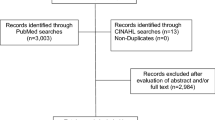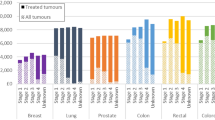Abstract
Purpose
To examine racial/ethnic disparities in mastectomy practice and explore mediating factors to explain the disparity.
Methods
Participants included 989 females aged 30–79 years, from a population-based study of newly diagnosed (primary in situ/invasive) breast cancer patients, in Chicago, Illinois, from 2005 to 2008, who completed an interview. Medical records were also abstracted for tumor, diagnostic, and treatment information. Multivariable logistic regression models with model-based standardization were used to estimate risk differences. Differences in rescaled coefficients were used to estimate the proportion of the disparity that could be mediated by patient and tumor characteristics.
Results
Mastectomy prevalence overall was 40 %. Factors significantly associated with increased rates of mastectomy (p < 0.05) included the following: non-Hispanic (nH) black and Hispanic race/ethnicity; younger age at diagnosis; lower socioeconomic status (SES); lack of recency of and adherence to screening mammography; and higher tumor pathologic stage and grade. In adjusted models (age, body mass index, comorbidity), compared to nH white patients, mastectomy was increased by 10 % points in both nH black (95 % confidence interval [CI] 0.03, 0.18; p = 0.007) and Hispanic (95 % CI 0.01, 0.19; p = 0.028) patients. After accounting for the proportion of disparity mediated by tumor stage, the disparity was reduced by about a third in nH black (risk difference = 0.07, 95 % CI −0.01, 0.14) and half in Hispanic patients (risk difference = 0.04, 95 % CI −0.05, 0.13). Additional control for mediation by SES and other tumor-related factors almost completely eliminated the nH black:nH white disparity.
Conclusions
The best approach to reducing the racial/ethnic disparity in mastectomy rates would be to intervene on factors that could affect stage at diagnosis.

Similar content being viewed by others
References
Siegel R, Naishadham D, Jemal A. Cancer statistics, 2013. CA Cancer J Clin. 2013;63(1):11–30.
Dehal A, Abbas A, Johna S. Racial disparities in clinical presentation, surgical treatment and in-hospital outcomes of women with breast cancer: analysis of nationwide inpatient sample database. Breast Cancer Res Treat. 2013;139(2):561–569.
Habermann EB, Abbott A, Parsons HM, Virnig BA, Al-Refaie WB, Tuttle TM. Are mastectomy rates really increasing in the United States? J Clin Oncol. 2010;28(21):3437–3441.
Ward E, Halpern M, Schrag N, et al. Association of insurance with cancer care utilization and outcomes. CA Cancer J Clin. 2008;58(1):9–31.
Fisher B, Anderson S, Bryant J, et al. Twenty-year follow-up of a randomized trial comparing total mastectomy, lumpectomy, and lumpectomy plus irradiation for the treatment of invasive breast cancer. N Engl J Med. 17 2002;347(16):1233–1241.
Ditlevsen S, Christensen U, Lynch J, Damsgaard MT, Keiding N. The mediation proportion: a structural equation approach for estimating the proportion of exposure effect on outcome explained by an intermediate variable. Epidemiology (Cambridge, Mass.). 2005;16(1):114–120.
Cummings P. The relative merits of risk ratios and odds ratios. Arch Pediatr Adolesc Med. 2009;163(5):438–445.
Rauscher GH, Ferrans CE, Kaiser K, Campbell RT, Calhoun EE, Warnecke RB. Misconceptions about breast lumps and delayed medical presentation in urban breast cancer patients. Cancer Epidemiol Biomark Prev. 2010;19(3):640–647.
CDC. Adult BMI. 2014. http://www.cdc.gov/healthyweight/assessing/bmi/adult_bmi/. Accessed 22 April 14, 2014.
Sampson RJ, Morenoff JD, Earls F. Beyond social capital: spatial dynamics of collective efficacy for children. Am Sociol Rev. 1999;64:633–660.
Browning CR, Wallace D, Feinberg SL, Cagney KA. Neighborhood social processes, physical conditions, and disaster-related mortality: the case of the 1995 Chicago heat wave. Am Sociol Rev. 2006;71(4):661–678.
Kohler U, Karlson KB, Holm A. Comparing coefficients of nested nonlinear probability models. Stata J. 2011;11(3):420–438.
Hawley ST, Griggs JJ, Hamilton AS, et al. Decision involvement and receipt of mastectomy among racially and ethnically diverse breast cancer patients. J Natl Cancer Inst. 2009;101(19):1337–1347.
Mauri D, Pavlidis N, Ioannidis JPA. Neoadjuvant versus adjuvant systemic treatment in breast cancer: a meta-analysis. J Natl Cancer Inst. 2005;97(3):188–194.
Yancik R, Wesley MN, Ries LG, Havlik RJ, Edwards BK, Yates JW. EFfect of age and comorbidity in postmenopausal breast cancer patients aged 55 years and older. JAMA. 2001;285(7):885–892.
Cui Y, Whiteman MK, Flaws JA, Langenberg P, Tkaczuk KH, Bush TL. Body mass and stage of breast cancer at diagnosis. Int J Cancer. Journal international du cancer. 2002;98(2):279–283.
Hall HI, Coates RJ, Uhler RJ, et al. Stage of breast cancer in relation to body mass index and bra cup size. Int J Cancer. Journal international du cancer. 2 1999;82(1):23–27.
Morris CR, Cohen R, Schlag R, Wright WE. Increasing trends in the use of breast-conserving surgery in California. Am J Public Health. 2000;90(2):281–284.
Nattinger AB, Gottlieb MS, Veum J, Yahnke D, Goodwin JS. Geographic variation in the use of breast-conserving treatment for breast cancer. N Engl J Med. 1992;326(17):1102–1107.
Fisher B, Redmond C, Poisson R, et al. Eight-year results of a randomized clinical trial comparing total mastectomy and lumpectomy with or without irradiation in the treatment of breast cancer. N Engl J Med. 1989;320(13):822–828.
Fisher B, Anderson S, Redmond CK, Wolmark N, Wickerham DL, Cronin WM. Reanalysis and results after 12 years of follow-up in a randomized clinical trial comparing total mastectomy with lumpectomy with or without irradiation in the treatment of breast cancer. N Engl J Med. 1995;333(22):1456–1461.
Enewold L, Zhou J, McGlynn KA, et al. Racial variation in breast cancer treatment among Department of Defense beneficiaries. Cancer. 2012;118(3):812–820.
Michalski TA, Nattinger AB. The influence of black race and socioeconomic status on the use of breast-conserving surgery for medicare beneficiaries. Cancer. 1997;79(2):314–319.
McGinnis LS, Menck HR, Eyre HJ, et al. National Cancer Data Base survey of breast cancer management for patients from low income zip codes. Cancer. 2000;88(4):933–945.
Bradley CJ, Given CW, Roberts C. Race, socioeconomic status, and breast cancer treatment and survival. J Natl Cancer Inst. 2002;94(7):490–496.
Joslyn SA, Foote ML, Nasseri K, Coughlin SS, Howe HL. Racial and ethnic disparities in breast cancer rates by age: NAACCR Breast Cancer Project. Breast Cancer Res Treat. 2005;92(2):97–105.
Dookeran KA, Dignam JJ, Holloway N, et al. Race and the prognostic influence of p53 in women with breast cancer. Ann Surg Oncol. 2012;19(7):2334–2344.
Lund MJ, Butler EN, Hair BY, et al. Age/race differences in HER2 testing and in incidence rates for breast cancer triple subtypes: a population-based study and first report. Cancer. 2010;116(11):2549–2559.
Independent UK Panel on Breast Cancer Screening. The benefits and harms of breast cancer screening: an independent review. Lancet. 2012;380(9855):1778–1786.
Acknowledgment
Supported in part by National Cancer Institute (Grants 2P50CA106743-06 and 1P50CA106743-01) and the Komen Foundation (Grant KG111385). Dr. Silva’s work was supported by the Office of Academic Affiliations, Department of Veterans Affairs.
Disclosure
The authors declare no conflict of interest.
Author information
Authors and Affiliations
Corresponding author
Rights and permissions
About this article
Cite this article
Dookeran, K.A., Silva, A., Warnecke, R.B. et al. Race/Ethnicity and Disparities in Mastectomy Practice in the Breast Cancer Care in Chicago Study. Ann Surg Oncol 22, 66–74 (2015). https://doi.org/10.1245/s10434-014-3945-6
Received:
Published:
Issue Date:
DOI: https://doi.org/10.1245/s10434-014-3945-6




